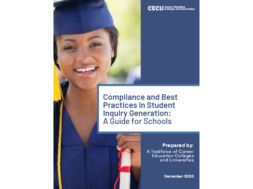
The Future of Marketing Education
By Kristopher T. Loretz, President, Southeastern College
Over the vast course of educational history, recruitment practices have evolved. It used to be that education was for the elite and privileged or academic savant. Students chose their post-secondary education based upon location and institutional merit, and often times a desire to attend the alma mater of one’s heritage, along with the prestige and academic fervor of a name, like “Harvard.” Then came the 20th century with financial assistance from the government and student loans, a desire to break away from the “ties that bind” and a growing number of opportunities, students became more selective when reviewing their multiple options for postsecondary education. With this change in attitude, colleges and universities began actively recruiting athletes and academic scholars through college fairs and guidance office visits. These institutions purchased mailing lists of potential students from the SAT and ACT Boards, which enabled them to selectively target students of specific academic and social demographics with phone calls, brochures and scholarship opportunities. Then … the internet was born.
With the implementation of the World Wide Web (www) a new age of recruitment and marketing was born. Information was now available at the push of few buttons and the youth of the day took off with this new technology.
Learning and embracing it, they developed ways to use it to their advantage. Strategically targeted email campaigns directing prospects to an institution’s website soon became the normal preliminary recruitment tool. Then came search engines like AOL, Google, Bing, Yahoo and many, many more. These search engines became the go to “place” to begin one’s research. No longer did the prospect need brochures or desire phone calls. The recruiter became the recruited, as tech-savvy prospects began seeking their desired educational goals online. Soon information was shared at a rapid pace and views and ideas were exchanged on a minute-by-minute basis through what would soon become known as social media.
Starting with AOL Instant Messenger and developing into sites like the now almost debunked Myspace and ever impressive Facebook, Instagram and TikTok, social media began to run rampant, controlling the web and the success or failure of so many businesses, including academic institutions. And, with the ever-developing and improving web-based “app functions” on smartphones, educational institutions that desire to remain relevant must strive to be one of the first to develop new means of recruiting using this technology.
The future is now
To succeed in today’s higher education market, colleges and universities must incorporate a social media presence into every aspect of their academic and social offerings in order to successfully enhance their recruitment and marketing tactics. These businesses will begin to heavily utilize instant communication through text, pre-recorded video messaging, wall posting, Twitter feeds and more. In some cases, schools are already looking at conducting recruitment interviews through face-to-face Skype or Zoom interviews to make the process easy and technologically exciting for prospective students (Mintz, 2014). And with the Pandemic, these methods of recruitment have become almost a necessity and no longer an option.
One of the reasons institutions jumped so quickly on the social media bandwagon is because if they don’t, other schools will. The old adage is still true today, and even more so, “First to contact – First to contract!” Our society today desires instant gratification. And if “Alexa” or “Siri” or “Hey Google” cannot give students the information they want, they’ll go with the information they get. Meaning, if someone “asks” for a culinary school in North Carolina, and they find one belonging to another school, chances are they will visit and possibly enroll at that school first.
Effectively marketing and recruiting for higher education
Anyone who has been involved in, or has researched effective campus marketing in any way, knows the change direct marketing has taken in its approach to targeting prospective students. It used to be that schools would bombard high-school juniors and seniors with the traditional “snail-mail” brochures and wait for them to return the inquiry card requesting more information. Colleges and universities were able to control, for the most part, when inquiries would come in, allowing the school to direct the admission cycle.
Nowadays, the potential student begins gathering information years before the official college search even begins. Indirect marketing begins via so many sources that prospective students no longer rely on printed material or mail from schools. In reality, many institutions do not even know they are being considered as a potential college until they receive the student’s application for review. In an e-recruitment practice study, completed by Noel-Levitz researching trends for two- and four-year public and private campuses, it was determined that 30% of applicants first made contact when they applied to the school online (Noel-Levitz, 2013).
Strategy and effective planning
Social media, mobile media and other forms of online and multimedia marketing are and will forever be changing the recruitment landscape for all types of educational organizations. According to a similar Noel-Levitz study, 74% of prospective college students said they had browsed college sites, or completed web-based research using their mobile device and 47% stated they communicated with college via email regularly (Noel-Levitz, 2013). This leads us to an example of one of the newest challenges with institutional marketing via electronic mail. It has become increasingly difficult to develop email messages due to the always adapting and updating spam filters. Even carefully crafted recruitment emails can be caught up by them.
Data mining
Data mining uses statistics to discover patterns in various factors. This data is often evaluated to give businesses copious amounts of valuable insight on customer behaviors, habits, and more which enables the institution to more effectively market to prospects. Data mining is valuable in the sense that it extracts specific, predictive information on individual customers; whereas more traditional marketing research identifies factors that influence entire buying communities. This research is more long-term, and data mining relies on readily available information (Hayes, Ph.D., 2009). The field of market research has been transformed by the practice of data mining.
Keys to enhancing marketing
In order to effectively enhance an institution’s marketing, they must identify various key factors. It is important that the organization’s marketing team determine, via data mining, who their prospect list is. The success of a direct marketing campaign depends on using the right list. This becomes especially true in the increasingly competitive and compliant world of enrollment management. Communication with this list at the most strategic time is imperative. Schools should look at the student search process as an ongoing event. As noted previously, the shift in marketing strategies has changed when campuses need to communicate with students (Anton, 2013).
When identifying key factors and developing a strategic marketing plan, it is important to develop a compelling offer that will generate an active response from your prospective clientele.
When it comes to students, the easiest thing to offer them is more information about the school.
The thought process behind this is that the potential student requests the additional information, automatically enters your lead flow and then continues through the application process (Anton, 2013). Although this thought process may have at one time been accurate and effective, the offer of information in this day and age must be presented in a manner that provides actual value to the prospect. Marketing teams must identify what is meaningful to potential students as they conduct their college search (Harris, 2014).
The final factor to consider in developing a strategic marketing plan to enhance your recruitment marketing is developing the right creative approach. When prospective students receive a direct mail letter or email, they want to know the WIIFM or “What’s In It For ME?” value (Hayes, Ph.D., 2009). Students want to know why they should choose one institution over another – and what’s in it for them if they do. So, it’s important that schools determine what they want to tell prospects about themselves; what they stand for; their mission statement and brand promise. Not all of these details may appeal to students, but it is more apt to do so, if the marketing also includes the value for the student, such as putting them first. By utilizing data mining to find out what is on the students’ minds, marketing can be directly targeted to the correct audience. The best way to do this – use technology more strategically (Anton, 2013).
Brand promise versus mission statement
As we examine an institution’s brand promise versus its mission statement, it is very important to differentiate between the two. One’s “brand promise” whether explicit or implicit, tells the customer what the outlined expectation of goods should be. Whereas, an organization’s “mission statement” should tell a customer the institution’s values, and plan to incorporate said values into the delivery of the “brand promise.”
Brand promise
Does it matter if an organization has a brand promise? Absolutely. A mission statement tends to be a specific, detailed and heavy worded paragraph, which utilizes large, and often vague wording, to deliver a message that can often be summed up quite simplistically. Most mission statements could easily replace each other in the world, as they all essentially state the same thing. However, a brand promise is specifically detailed to your customer base. In fact, it is more of a summary of your institution’s mission statement, focusing on one or two essential key areas. Your brand promise is not a tagline either. It is not meant to generate excitement about a product, but rather as a point of reference for future interactions between yourself and those clients you serve. That’s part of what’s implied … a promise between the important players, your clientele, and the institution’s staff (Hayes, Ph.D., 2009).
Many clients consider the brand promise to be, what is referred to in the sales world, as the WIIFM, or “What’s In It For Me?” item (Cordeiro & Cunningham, 2013). In reference to the school environment, this takes the catchiness of the institution’s tagline, and reinforces the basis of the school’s mission statement. Often the brand promise is the last part of a business plan to be developed, but it is one of the most important areas an organization should focus on. The brand promise statement must be believable. It is the commitment to the customer, and you had better be able to fulfill it.
Mission statement
An organization’s mission statement states what the intention is and answers the unasked question of how an institution is going to achieve the intention. Mission statements describe why a company exists, while supporting the outlined goals of the overall vision. The mission statement of any institution should be clear, something that can be acted upon realistically, and specific for all employees in the organization.
Although it is recommended that the mission statement be kept short, most are not.
An institution’s mission statement is the focal point for developing an organization’s value propositions. Mission statements should state a school’s intention to provide a high-quality education through verifiable means. Delivering education in a product relevant and informative manner that enhances the lives of its students (Mintz, 2014). Mission statements should hold relevant meaning in the values that underlie the statement. A mission statement will be the defining guide for your organization, bringing focus and assistance during transitional periods and when making decisions that impact the direction of the organization.
Marketing
When developing marketing communication plans, it is important that the marketing team have a full understanding of what the institution’s mission statement is and that they support it. It is also valuable for the marketing team to be a part of developing the brand promises that go along with the organization’s mission statement, since ultimately it is their responsibility to ensure the correct message is received by the public, and the potential customer.
In determining how best to market these two areas to the public, the marketing team must analyze how both the mission statement and the brand promise exude quality, reliability, education and enhancement (Hayes, Ph.D., 2009). It is also important to decide exactly how the marketing is going to be targeted. Based upon the intended audience, the direction in which one takes the marketing plan, and how focused it is on the brand promise versus the actual mission statement, will determine the scope of the strategic plan. For example, when marketing towards a group of investors or more business focused entities, one may directly reference and market to the mission statement of an organization; but when looking to attract clientele, specifically students, the institution may look to focus more on the brand promise of what, where, when, who and how the client services will be delivered, in a simple and direct manner.
As much as marketing the mission statement is important, so is contributing to the brand promise. Branding goes beyond any one particular marketing effort since the brand remains in the minds of the customer, or potential customer long after any marketing campaign has ended. That which sticks in your mind is what you associate with the organization’s product or service.
Conclusion
The results of my research raise the question of the perceived value of traditional marketing practices among educational institutions. More importantly, we must understand that the development of foundational marketing practices is no longer possible. Institutions must develop practices unique to the outcomes they desire, not just what they expect. Brand recognition will be key and depending upon the location of the school and the student demographics of the institution is recruiting for, will determine the appropriate tactic and effort put forth for the desired outcomes. So, in conclusion, the future of marketing is more client focused and driven. There can be no “cookie-cutter” formula.
In particular, studies suggest that the speed of communication and dissemination of consumer information will be most relevant to the future of marketing. Many institutions today have negatively diluted the perception of some forms of higher education, decreasing the value of the traditional form of marketing and giving rise to the substitution of alternate, more upfront, recruitment methods (Finch, Nadeau, & O’Reilly, 2012). This perceived threat is one that professional marketing teams face regularly.
Therefore, it can be concluded that competitive marketing must emphasize the skill developments and unique practices of the higher educational institution it is developed for. Such an approach will guarantee relevancy in the here and now, as well as in the future. Developing and executing direct student marketing can be challenging. As a valuable component of recruitment, progressive marketing teams must adapt to the ever-changing realities of today’s marketing world (Noel-Levitz, 2013). Implementing social media tactics without an effective strategic plan is without question, bad business. Adding marketing tactics without understanding how the business goals, objectives and measurement will be achieved is a sure fire way to see failure.
Despite the changes in modern marketing and technology, there has been no change in basic business.
Organizations exchange a service or provide a product and in turn receive compensation of some sort. The success of the said organization, depends upon the awareness of the consumer and that is where strategic marketing comes into play.
To succeed as an organization, the marketing team must understand the needs, as well as desires of your current clientele and prospective customers. This is accomplished by incorporating the institution’s brand promises through every point of potential contact and redirecting the public to the ideals of the organization’s mission statement. Once the brand resides within the memory of the clientele, it becomes the perception.
Strong marketing incorporative of both the brand promises and the mission statement is what will result in long-term success for any institution, organization, business or individual.
References
Anton, P. (2013). 2013 White Paper: Five Principles of a Successful Prospective Student Direct Marketing Campaign. Coralville: Noel-Levitz, LLC.
Cordeiro, P. A., & Cunningham, W. G. (2013). Educational Leadership: A Bridge to Improved Practice (5th ed.). Upper Saddle River, NJ: Pearson.
Duncan, A. (2012). Investing in America’s Future. Washington D.C.: US Department of Education: Office of Vocational Education.
Finch, D., Nadeau, J., & O’Reilly, N. (2012). The Future of Marketing Education. Journal of Marketing Education, 1(35), 54–67.
Harris, M. (2014). The End of Absence: Reclaiming What We’ve Lost in a World of Constant Connection. New York: The Penguin Group.
Hayes, Ph.D., T. J. (2009). Marketing Colleges and Universities: A Services Approach. Washington, DC: Council for Advancement and Support of Education.
Mintz, S. (2014, October 15). New Models of Higher Education. Retrieved from Inside Higher Ed: https://www.insidehighered.com/blogs/higher-ed-gamma/new-models-higher-education
Noel-Levitz. (2013). 2013 marketing and student recruitment practices benchmark report for four-year and two-year institutions. Coralville: Noel-Levitz, LLC.
Norris, J. (2014). The Future of College Recruitment. Retrieved from University Business
KRIS LORETZ’S career has been in leadership and relationship building for over 20 years. He’s proven himself as someone who is forward-thinking and who can successfully grow an organization with a focus on community and goals. In his professional and personal experiences, he focuses on compassion and respect. Kris has received multiple promotions professionally with non-profit, private and proprietary organizations.
His proven record of success includes managing all aspects of business operations, driving growth through increased client development and attrition, maintaining strong profit margins and low debit balances, while significantly limiting bad debt expenses. His responsibilities include active involvement in impacting advertising, marketing, staff development and retention, strategic planning and outcomes reporting.
Currently, he is the President of Southeastern Institute in Charlotte, NC. Mr. Loretz was appointed to the North Carolina Proprietary School Board by the General Assembly’s Speaker of the House. He holds the position of President with the North Carolina Association of Career Colleges and Schools. And he serves as the Chairman for the advisory committee to the North Carolina Community College system’s Office of Proprietary Schools.
In 2011, Kris acted upon his industry vision and created Complete Educational Solutions, where he and his network of connections, consult with colleagues and educational organizations on how to improve outcomes and foster strong management techniques that produce a culture based on integrity. This organization focuses on meeting the ever-changing, and always important, current industry and societal standards.
His experience includes, but is not limited to, state, national and programmatic accreditation standards, as well as start-up programs and regulatory approvals. With a strong compliance focus, Kris prides himself on being solution driven, detail oriented, and quick to learn and utilize new skills, while focusing on a team mindset with strong communication skills that exude energy and passion.
Contact Information: Kristopher T. Loretz // President // Southeastern Institute // 704-527-4979 // kloretz@southeasterninstitute.edu // www.southeasterninstitute.edu // https://www.linkedin.com/in/kloretz/ // https://www.linkedin.com/school/southeastern-institute/ // https://www.facebook.com/SoutheasternCollegeHigherEd // https://www.instagram.com/seceducation/ // https://www.youtube.com/channel/UCS0RYoZT3OSRgyV1tErOf1g











